Snow Cannon Halos, Sweden - OPOD
Snow Cannon Halos, Sweden - OPOD: A Rare Atmospheric Phenomenon
Snow Cannon Halos are a mesmerizing and rare atmospheric optical display that occurred in Sweden on December 27th. Captured by photographer Peter Roos, these images showcase an array of stunning halos, including the Parry arc, helic arc, supralateral arc, and even hints of the Parry supralateral and Moilanen arcs. These captivating phenomena were brought about by the operation of snow cannons on nearby ski slopes.
Snow cannons are devices used to create artificial snow on ski slopes. They function by spraying nuclei into the air, which act as a foundation for the rapid growth of snow crystals. However, as a by-product of this process, some nuclei drift far downwind, and tiny ice crystals form around them, resulting in the creation of beautiful halos. These ice crystals possess exceptional optical clarity, giving rise to bright diamond dust halos and arcs of great rarity.
The halos observed in the snow cannon display predominantly originate from Parry-oriented hexagonal columns. These columns exhibit a unique characteristic: while they drift with their long axes in a horizontal orientation, they do not rotate about this axis. Instead, they remain locked with two prism side faces positioned horizontally. This peculiar behavior adds to the allure of the phenomenon.
One of the most prominent halos in the display is the upper tangent and upper suncave Parry arcs. These arcs form a pair and their shapes and separation vary significantly with the elevation of the sun. The tangent arc lives up to its name, as it always forms a tangent to the 22° halo. The background image accompanying these arcs reveals the individual glints of the crystals suspended in the air. It is important to note that halos are collective glints produced by millions of these tiny ice crystals.
In addition to the Parry arcs, the snow cannon display also showcases rare helic arcs. These arcs are formed by the reflection of light off the side faces of the Parry-oriented columns. The precise formation mechanism of the Moilanen arc, observed in this particular display, remains unknown. It is a fascinating enigma that adds to the allure of this captivating atmospheric optical phenomenon.
These mesmerizing images of Snow Cannon Halos serve as a reminder of the intricacies and wonders of our atmosphere. They highlight the beauty that can arise from seemingly mundane processes such as the operation of snow cannons. Nature never ceases to amaze us with its ability to transform everyday occurrences into extraordinary spectacles. The Snow Cannon Halos of Sweden are a testament to the grandeur and complexity of atmospheric optics.
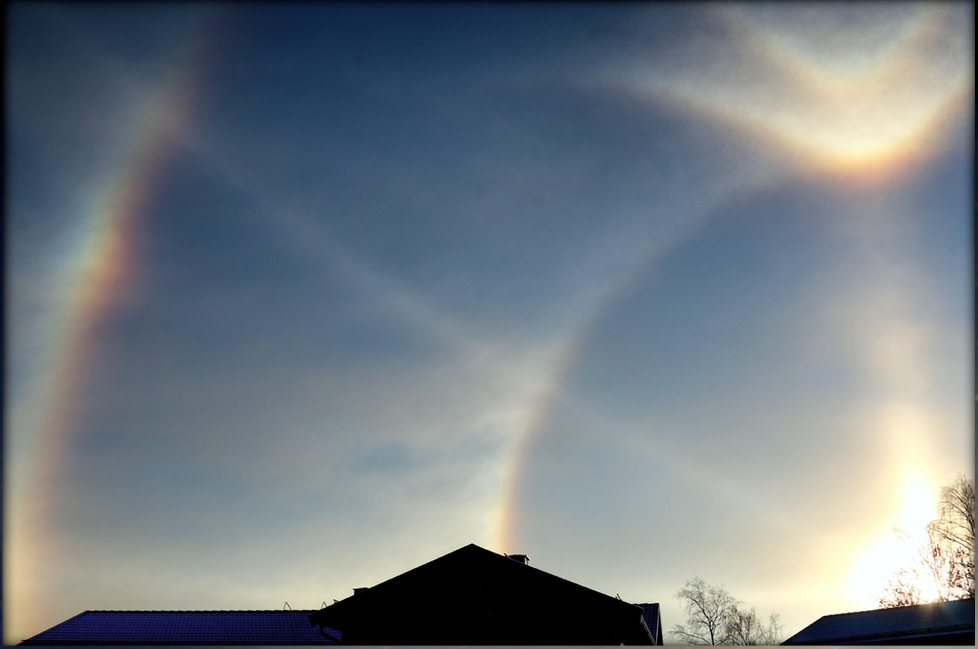
Snow Cannon Halos
Images by Peter Roos in Sweden on 27th December.
Rare halos dominate the scene with an unbelievably bright Parry arc, helic arc, supralateral arc and even a trace of a Parry supralateral and Moilanen arcs. See the labelled image below left.
Snow cannons were operating in two nearby ski slopes and they were responsible. The cannons spray nuclei on which snow crystals rapidly grow. But as a by-product some nuclei drift far downwind and tiny halo forming ice crystals grow slowly around them. The crystals are almost optically perfect and thus form bright diamond dust halos and arc of great rarity.
All images ©Peter Roos, shown with permission
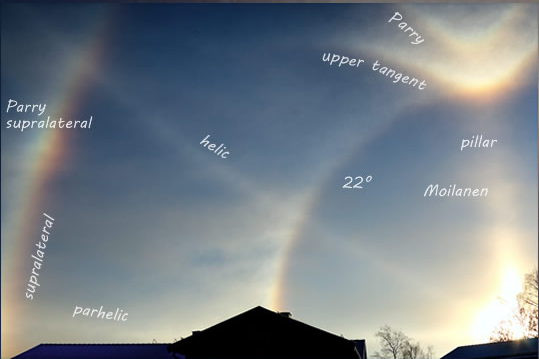
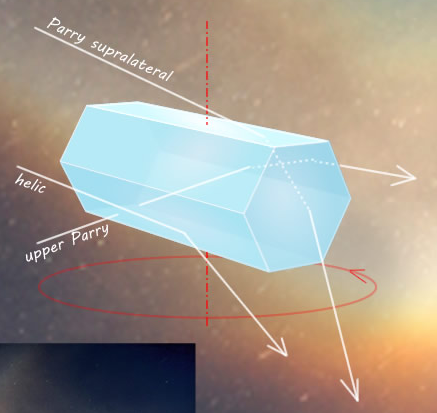
The display's rare halos are all from Parry oriented hexagonal columns. With the exception of the Moilanen arc that is - we do not know what crystals form that one.
Parry crystals drift with their long axes horizontal. Strangely, the crystal does not rotate about this axis but instead it is locked with two prism side faces horizontal.
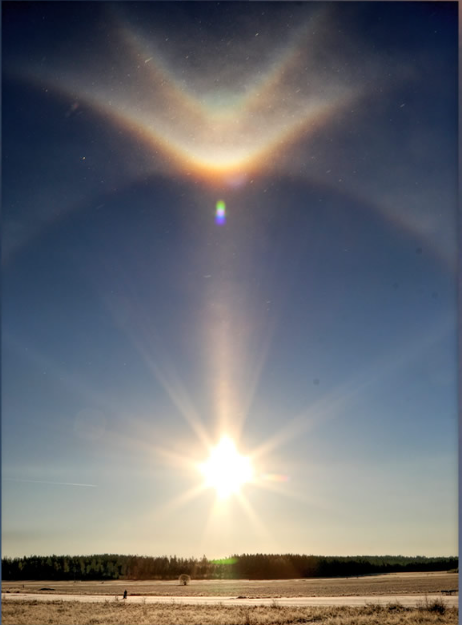
Left: The upper tangent and upper suncave Parry arcs form a pair. Their shapes and separation vary strongly with the sun's elevation.
The tangent arc always does what it says - form a tangent to the 22° halo.
The background image shows the individual glints of the crystals floating nearby. Halos are the collective glints of millions of crystals.
Lower image: Another view of the rare helic arcs formed by reflection off the side faces of Parry oriented columns.
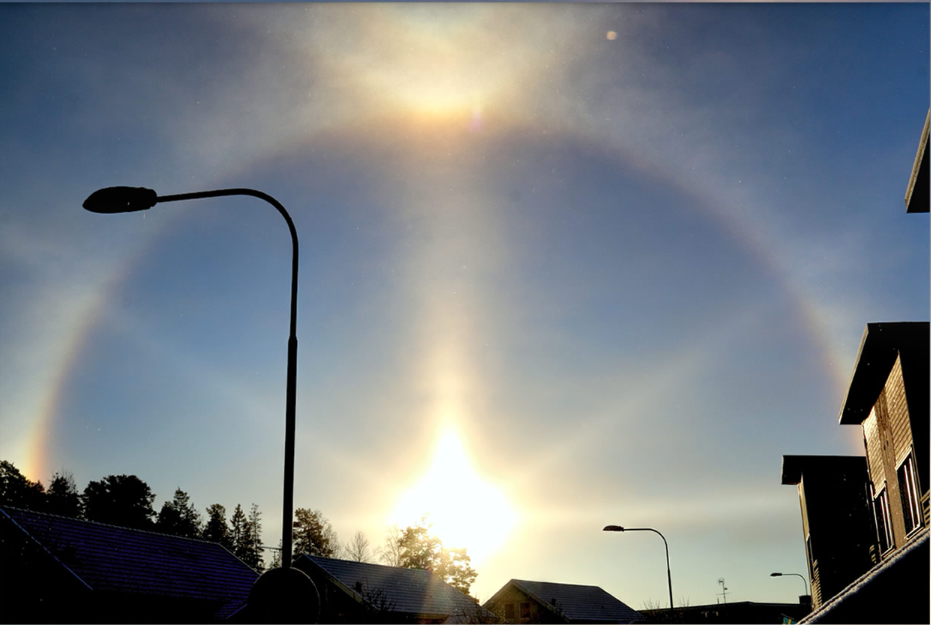
Note: this article has been automatically converted from the old site and may not appear as intended. You can find the original article here.
Reference Atmospheric Optics
If you use any of the definitions, information, or data presented on Atmospheric Optics, please copy the link or reference below to properly credit us as the reference source. Thank you!
-
<a href="https://atoptics.co.uk/blog/snow-cannon-halos-sweden-opod/">Snow Cannon Halos, Sweden - OPOD</a>
-
"Snow Cannon Halos, Sweden - OPOD". Atmospheric Optics. Accessed on April 19, 2024. https://atoptics.co.uk/blog/snow-cannon-halos-sweden-opod/.
-
"Snow Cannon Halos, Sweden - OPOD". Atmospheric Optics, https://atoptics.co.uk/blog/snow-cannon-halos-sweden-opod/. Accessed 19 April, 2024
-
Snow Cannon Halos, Sweden - OPOD. Atmospheric Optics. Retrieved from https://atoptics.co.uk/blog/snow-cannon-halos-sweden-opod/.